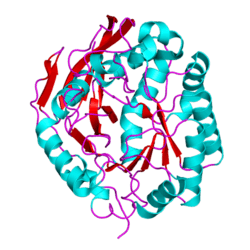CAD (protein)
| View/Edit Human | View/Edit Mouse |
| carbamoyl-phosphate synthetase 2, aspartate transcarbamylase, and dihydroorotase | |
|---|---|
| Identifiers | |
| Symbol | CAD |
| Entrez | 790 |
| HUGO | 1424 |
| OMIM | 114010 |
| RefSeq | NM_004341 |
| UniProt | P27708 |
| Other data | |
| EC number | 2.1.3.2 |
| Locus | Chr. 2 p21 |
CAD protein (carbamoyl-phosphate synthetase 2, aspartate transcarbamylase, and dihydroorotase) is a trifunctional multi-domain enzyme involved in the first three steps of pyrimidine biosynthesis. De-novo synthesis starts with cytosolic carbamoylphosphate synthetase II which uses glutamine, carbon dioxide and ATP. This enzyme is inhibited by uridine triphosphate (feedback inhibition).
In 2015, the first observed pathological mutations of CAD were found in a four-year-old boy.[3]
References
- ↑ "Human PubMed Reference:".
- ↑ "Mouse PubMed Reference:".
- ↑ Ng, B. G.; Wolfe, L. A.; Ichikawa, M.; Markello, T.; He, M.; Tifft, C. J.; Gahl, W. A.; Freeze, H. H. (12 February 2015). "Biallelic mutations in CAD, impair de novo pyrimidine biosynthesis and decrease glycosylation precursors". Human Molecular Genetics. 24 (11): 3050–3057. doi:10.1093/hmg/ddv057.
External links
- CAD trifunctional enzyme at the US National Library of Medicine Medical Subject Headings (MeSH)
This article is issued from Wikipedia - version of the 11/16/2016. The text is available under the Creative Commons Attribution/Share Alike but additional terms may apply for the media files.
